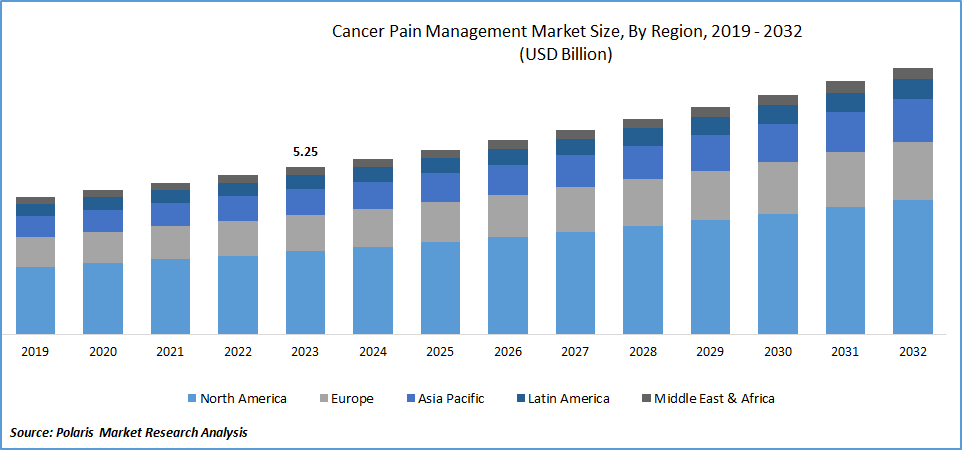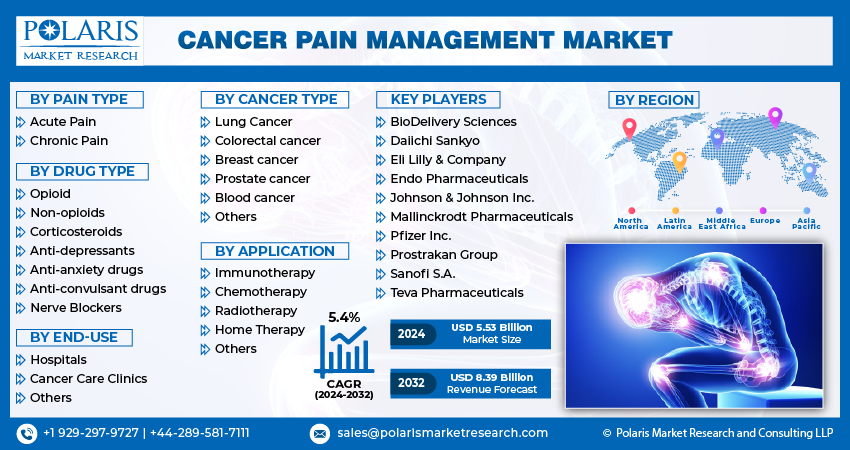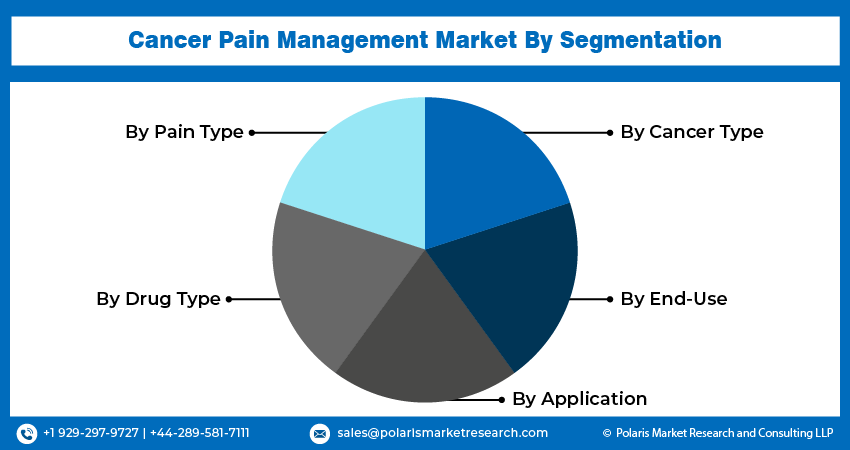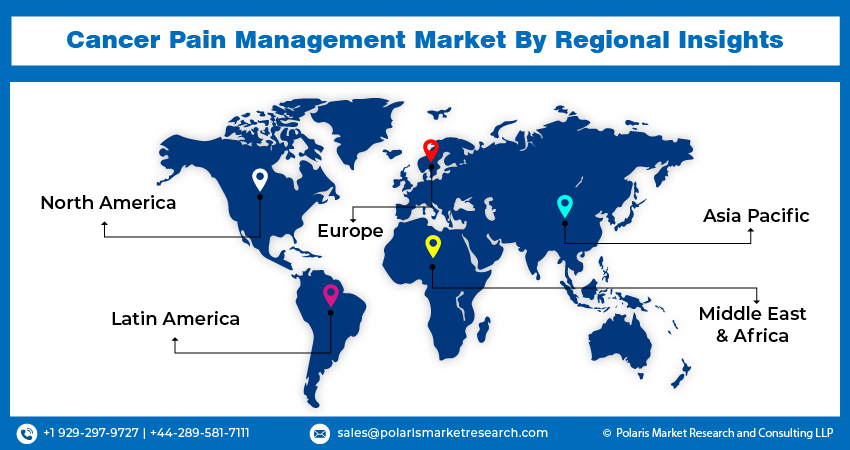
Cancer Pain Management Market Share, Size, Trends, Industry Analysis Report
By Pain Type (Acute Pain, Chronic Pain); By Drug Type; By Cancer Type; By Application; By End-Use; By Region; Segment Forecast, 2025 - 2034
- Published Date:May-2025
- Pages: 117
- Format: PDF
- Report ID: PM1320
- Base Year: 2024
- Historical Data: 2020-2023
The global cancer pain management market was valued at USD 6 billion in 2024 and is expected to grow at a CAGR of 4.50% from 2025 to 2034. Market growth is fueled by rising cancer incidence and the need for effective palliative care solutions.
Cancer Pain Management Market Overview
The cancer pain management market is experiencing rapid growth owing to the pain experienced by cancer patients is typically persistent and requires effective management for relief. Medication forms the cornerstone of cancer pain management, with options such as aspirin-like drugs, paracetamol, and opioid drugs being commonly used. In addition to medication, relaxation therapies such as tai chi, massage, yoga, hypnotherapy, and meditation can also be beneficial. Properly managed pain can lead to an enhanced quality of life, improved sleep, increased energy levels, and reduced risk of complications associated with immobility, such as pneumonia, blood clots, and bedsores.

To Understand More About this Research:Request a Free Sample Report
- For instance, in January 2024, The Collaborative Care Program at Lipson Cancer Institute combined Palliative Care and Behavioral Health services to address the individual needs of patients at different stages of treatment. Through thorough psychological evaluations, counseling, and intervention strategies, the program aims to alleviate emotional distress and enhance overall well-being.
Tailored medication regimens, including NSAIDs and opioids, are essential to minimize side effects and maximize benefits. Combinations of medications are often utilized to achieve optimal results. Furthermore, treatments such as surgery, radiotherapy, chemotherapy, and hormone therapy, if effective in shrinking tumors, can also help alleviate pain. Additional supportive techniques have recently been adopted as therapies that may offer better pain management and relief in cancer patients.
However, proper breathing techniques can have a calming effect on the nervous system and effectively manage stress. Hypnotherapy assists in alleviating certain side effects of cancer treatment, including nausea. Massage therapy works by soothing the soft tissues and promoting relaxation. Tai chi, a non-combative martial art form originating from China, involves gentle movements that aim to clear the mind and induce bodily relaxation.
Cancer Pain Management Market Dynamics
Market Drivers
- Rising Geriatric Population
The rising geriatric population all over the world has a higher risk of developing cancers, which has led to advancements in cancer treatment, care, and pain management. The impact of pain on frail older adults with cancer is quite substantial, with the intensity often being significant. The aging process brings about changes in the way medications are processed and interact with the body. This includes a narrower range of effective dosages, slower elimination of drugs due to liver and kidney function decline, and a decrease in the number of receptor sites available for drug binding, as well as a reduction in the overall volume of distribution within the body. Hence, there is a rise in demand for research and development of treatments in cancer pain management for the geriatric population particularly.
- Rising Technology in Cancer Pain Management
Advancements in technology have led to the discovery of a wristwatch-style device that constantly monitors physiological functions and reactions, including heart rate, body temperature, and movement, and sensors placed in rooms that track environmental conditions and behaviors within the household that could impact pain such as fluctuations in temperature, levels of light, visitor movements, and disruptive noises.
Market Restraints
- High Treatment Costs
The high cost associated with cancer pain management treatment impedes the growth of this market. The development and production of advanced medications and therapies aimed at alleviating pain involve intricate research processes, resulting in high production costs. Moreover, the complexity of cancer pain necessitates the expertise of specialized healthcare professionals, further driving up expenses. Furthermore, the need for personalized care and ongoing monitoring to effectively manage pain contributes to continuous healthcare expenditures. The escalating costs of medications also hinders the market growth, particularly in developing and underdeveloped countries, leading to inadequate treatment for numerous patients.

Report Segmentation
The Cancer Pain Management Market is primarily segmented based on pain type, drug type, cancer type, application, end-use, and region.
|
By Pain Type |
By Drug Type |
By Cancer Type |
By Application |
By End-Use |
By Region |
|
|
|
|
|
|
To Understand the Scope of this Report:Speak to Analyst
Cancer Pain Management Market Segmental Analysis
By Drug Type Analysis
- The opioids segment dominated the market, largely attributable to their property to alleviate moderate to severe pain. They are highly effective in providing relief for such pain levels. However, it has been observed that certain cancer patients may develop tolerance to opioids over time, resulting in diminished pain relief. In such cases, higher doses or an alternative opioid may be required to elicit the desired response from the body. To ensure consistent pain relief and prevent its escalation, opioids are administered on a regular schedule.
- The non-opioids drug segment is projected to grow at a CAGR during the projected period, mainly driven by its effectiveness in managing mild to moderate pain. Cancer patients often suffer from pain caused by tumor growth, nerve compression, or post-operative issues, and acetaminophen is a preferred choice for pain relief, either on its own or in conjunction with other painkillers. The safety profile of acetaminophen and its minimal interaction with other medications commonly prescribed in cancer treatment is driving the growth of this segment.
By Cancer Type Analysis
- The lung cancer segment accounted for the largest market share, attributed to the rising prevalence of lung cancer, a higher frequency of pain related to lung cancer, and the presence of efficient analgesics for treating cancer pain in lung cancer patients. The treatment options for lung cancer have expanded due to the growing popularity of Complementary and Alternative Medicine (CAM).
- The breast cancer segment is expected to grow at the fastest growth rate over the next coming years on account of the rapid increase in the demand for non-pain approaches that can be utilized to alleviate pain, such as acupressure, acupuncture, cognitive-behavioural therapy, Hot and cold therapy, guided imagery, hypnosis, massage therapy, mindfulness, meditation, music therapy, and other techniques.
By End-Use Analysis
- The hospitals segment dominated the market with a significant market share, which is highly accelerated due to various factors, including the increasing preference and trust of patients towards hospital settings, government initiatives to enhance healthcare infrastructure, and the ease of access to treatment facilities, are driving the growth of this sector. Additionally, the medications produced by different industry players following extensive research and development efforts directly support hospital pharmacies.
- The cancer care clinics is anticipated to grow with the fastest CAGR owing to their ability to efficiently convert inputs into outputs while being flexible and adaptable, allowing them to quickly adjust to changing patient conditions. Various clinical applications in cancer care deserve recognition, including clinical research, healthcare services, physical examinations, self-care practices, disease diagnosis and treatment, pharmaceutical and medical device therapies, surgical interventions, hospital administration, pharmacy services, medical quality control, and disease prevention measures.

Cancer Pain Management Market Regional Insights
The North America Region Dominated the Global Market with the Largest Market Share
The North America region dominated the market with the largest market share and is expected to maintain its dominance over the anticipated period. The growth of the segment market can be largely attributed to the increasing prevalence of cancer has created a greater demand for healthcare services. Additionally, advancements in technology have improved the quality of healthcare and made it more accessible to the general population. Moreover, the availability of pain therapeutics has made it easier for patients to manage their pain effectively. Furthermore, the region's favorable healthcare infrastructure has facilitated easy access to advanced pain management devices.
The Asia Pacific region is expected to be the fastest growing region with a healthy CAGR during the projected period, attributed to investments in research and development for the production of technologically advanced healthcare therapeutic options. Additionally, the strengthening of healthcare infrastructure, rising per capita income, growing elderly population, and increasing prevalence of advanced chronic pain in the region. As a result, the market in this region is expected to expand.

Competitive Landscape
The market for cancer pain management is highly competitive, with numerous industry participants focusing on creating innovative delivery methods for treating advanced cancer pain. This is expected to drive growth in the advanced cancer pain management market. Major market players are increasingly turning to inorganic growth strategies such as acquisitions, mergers, partnerships, and collaborations to enhance their product offerings.
Some of the major players operating in the global market include:
- BioDelivery Sciences
- Daiichi Sankyo
- Eli Lilly & Company
- Endo Pharmaceuticals
- Johnson & Johnson Inc.
- Mallinckrodt Pharmaceuticals
- Pfizer Inc.
- Prostrakan Group
- Sanofi S.A.
- Teva Pharmaceuticals
Recent Developments
- January 2025, The U.S. Food and Drug Administration approved Journavx (suzetrigine) 50 milligram oral tablets to treat moderate to severe acute pain in adults, including cancer pain.
- In July 2023, CARER and Wholeleaf joined forces to establish a collaborative effort to deliver a comprehensive approach to cancer care. By combining services and products, they aim to optimize the well-being of cancer patients.
- In January 2023, The Ministry of Social Affairs (Europe), the Health Insurance Fund, pharmaceutical companies MSD, AstraZeneca, and Roche, along with the Connected Health Cluster under the leadership of Tehnopol, have entered into a consortium agreement aimed at enhancing the lung cancer patient pathway through collaboration. This initiative is a collective effort to support the national cancer control plan.
Report Coverage
The cancer pain management market report emphasizes on key regions across the globe to provide better understanding of the product to the users. Also, the report provides market insights into recent developments, trends and analyzes the technologies that are gaining traction around the globe. Furthermore, the report covers in-depth qualitative analysis pertaining to various paradigm shifts associated with the transformation of these solutions.
The report provides detailed analysis of the market while focusing on various key aspects such as competitive analysis, pain type, drug type, cancer type, application, end-use, and their futuristic growth opportunities.
Cancer Pain Management Market Report Scope
|
Report Attributes |
Details |
|
Market size value in 2025 |
USD 6.27 billion |
|
Revenue forecast in 2034 |
USD 9.3 billion |
|
CAGR |
4.50% from 2025 – 2034 |
|
Base year |
2024 |
|
Historical data |
2020 – 2023 |
|
Forecast period |
2025 – 2034 |
|
Quantitative units |
Revenue in USD billion and CAGR from 2025 to 2034 |
|
Segments covered |
By Pain Type, By Drug Type, By Cancer Type, By Application, By End-Use, By Region |
|
Regional scope |
North America, Europe, Asia Pacific, Latin America, Middle East & Africa |
|
Customization |
Report customization as per your requirements with respect to countries, region and segmentation. |
FAQ's
Cancer Pain Management Market report covering key segments are pain type, drug type, cancer type, application, end-use, and region.
Cancer Pain Management Market Size Worth $ 8.39 Billion By 2032
Cancer pain management market exhibiting the CAGR of 5.4% during the forecast period
North America is leading the global market
The key driving factors in Cancer Pain Management Market are Rising Geriatric Population
